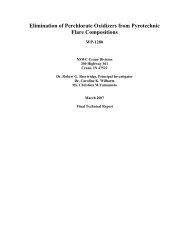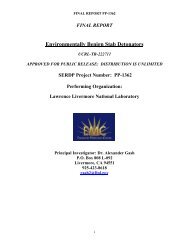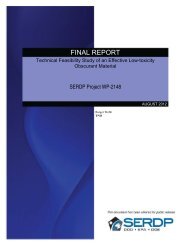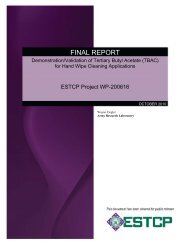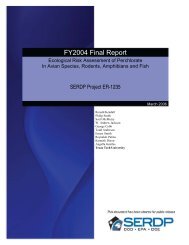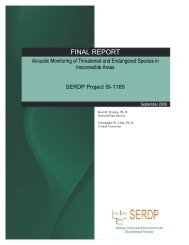Final Report - Strategic Environmental Research and Development ...
Final Report - Strategic Environmental Research and Development ...
Final Report - Strategic Environmental Research and Development ...
Create successful ePaper yourself
Turn your PDF publications into a flip-book with our unique Google optimized e-Paper software.
1. Background <strong>and</strong> Introduction<br />
1.1. Background<br />
The removal of components from military systems in the field which have become<br />
damaged due to wear, corrosion, impact, etc., their shipment to a depot, <strong>and</strong> subsequent<br />
overhaul <strong>and</strong> repair all generate either hazardous or industrial waste <strong>and</strong> represent a<br />
significant cost to the Department of Defense (DOD). It is therefore important that field<br />
repair of such components be performed whenever possible. Currently, brush plating is<br />
the only viable technology for field repair <strong>and</strong> it has extensive environmental problems.<br />
Hard chromium coatings are repaired by brush plating with nickel to rebuild <strong>and</strong> then<br />
finishing with a thin layer of brush-plated chromium which always utilizes a hexavalent<br />
chromium (hex-Cr) plating solution. Although nickel solutions are not as hazardous as<br />
chromium, Ni is coming under increasing environmental pressure. In general, with brush<br />
plating there are significant difficulties ensuring proper containment <strong>and</strong> minimizing<br />
personnel health hazards. There are many applications for which brush plating cannot be<br />
used <strong>and</strong> thus the components are returned to depots for repair where the damaged areas<br />
are machined away <strong>and</strong> the dimensions of the component are restored using electrolytic<br />
hard chrome (EHC) plating. If a technology could be validated that would both replace<br />
brush plating <strong>and</strong> provide field repair on currently non-repairable parts, then there would<br />
be a reduction in both waste generation <strong>and</strong> cost, plus readiness would also be affected<br />
because weapons systems would be returned to service in a shorter period of time.<br />
<strong>Final</strong>ly, there are many components that suffer significant damage <strong>and</strong> for which there is<br />
neither a field nor depot-level repair currently available. At present, these components<br />
must be scrapped, resulting in costs associated both with disposal <strong>and</strong> loss-of-use.<br />
Electrospark deposition (ESD), also known as electrospark alloying (ESA) is a microwelding<br />
technique that has demonstrated capability for filling damaged areas <strong>and</strong><br />
restoring coating damage. It uses short-duration, high-current electrical pulses to weld a<br />
consumable electrode material to a metallic substrate. Electrode materials may be nearly<br />
any electrically conductive metal or ceramic/metal (cermet) mixture capable of being<br />
melted in an electric arc. The ESD process is distinguished from other arc welding<br />
processes in that the spark duration is limited to a few microseconds <strong>and</strong> the spark<br />
frequency to around 1000 Hz or less. Thus, welding heat is generated during less than<br />
1% of a weld cycle, while heat is dissipated during 99% of the cycle. This provides<br />
extremely rapid solidification, resulting in a nanocrystalline structure or, in some cases,<br />
an amorphous surface layer. Regardless of the structure that is obtained, the coatings are<br />
extremely dense <strong>and</strong> they are metallurgically bonded to the substrate. The combination<br />
of extremely fine grain structure, high density, <strong>and</strong> high bond strength offer the<br />
possibility of achieving substantial corrosion resistance, augmented wear resistance, <strong>and</strong><br />
enhanced ductility. The low heat input eliminates thermal distortion or changes in<br />
metallurgical structure <strong>and</strong> thus allows the process to be used on heat-sensitive materials.<br />
ESD is also advantageous from an environmental <strong>and</strong> worker safety st<strong>and</strong>point. Best<br />
manufacturing practice generally recommends that in most applications a simple shroud<br />
with vapor exhaust be used to remove any fumes. The use of such a shroud ensures that<br />
operator exposure is below permissible exposure limits for any materials being deposited.<br />
1





